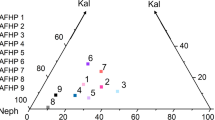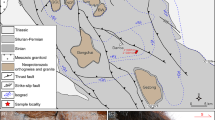Abstract
A mixture containing equal amounts of forsterite and grossularite by weight (Fo50Gr50) has been studied at temperatures between 750 and 1400°C under pressures ranging from 6 to 25 kbar in presence of excess water. The assemblages noted under low pressure (<8 kbar) are as follows:
Diopsidess+forsteritess+monticellitess+vapor and
Diopsidess+forsteritess+monticellitess+liquid+vapor. (ss denotes solid solution) Under intermediate pressures between 8 and 24 kbar following assemblages were noted in the order of increasing temperature:
Diopsidess+forsteritess+spinel+vapor,
Diopsidess+forsteritess+spinel+liquid+vapor,
Diopsidess+forsteritess+liquid+vapor, and
Forsteritess+liquid+vapor. At pressures above 24 kbar the assemblages are as follows:
Diopsidess+forsteritess+garnet+vapor,
Diopsidess+forsteritess+garnet+liquid+vapor,
Diopsidess+forsteritess+liquid+vapor, and
Forsteritess+liquid+vapor.
Electron microprobe analyses of diopside and forsterite crystallized at 1050°C and 23 kbar, show that the former contains 6 to 6.5 wt % of Al2O3 as solid solution whereas the latter incorporates 1.3 wt % of monticellite in solid solution. The monticellite content of forsterite increases at low pressures at a given temperature to about 6 wt % at 1050°C and 6 kbar.
The study indicates that forsteritic olivine does not coexist with pure grossularite in the studied temperature and pressure ranges, although the former is in equilibrium with pyrope-rich garnet, containing 23 mole % grossularite.
The study supports the conclusion ofWerner andLuth (1973) that the solubility of monticellite in forsterite decreases with increasing pressure at a given temperature. The results of the investigation are also in agreement with the findings ofKushiro andYoder (1966), who noted that spinel peridotites found in folded belts and in alkalic basalts are produced under intermediate pressures, whereas garnet peridotite xenoliths found in kimberlite and in orogenic belts are formed at high pressures.
Similar content being viewed by others
References
Eskola, P., 1921,On the Eclogites from Norway, Vidensk. Skr.,8, p. 70–74.
Forbes, R. B. andKuno, H., 1965,The Regional Petrology of Peridotite Inclusions and Basaltic Rocks. In: IUGS «Upper Mantle Symposium» New Delhi, 1964, p. 161–179.
Green, D. H., 1964,The Petrogenesis of the High Temperature Peridotite Intrusions in the Lizard Area, Cornwall. J. Petrol.,5, p. 134–188.
—————, andHibberson, W., 1970,The Instability of Plagioclase in Peridotite at High Pressure. Lithos,3, p. 209–221.
————— andRingwood, A. E., 1967,The Stability Fields of Aluminous Pyroxene Peridotite and Garnet Peridotite and Their Relevance in the Upper Mantle Structure. Earth Planet. Sci. Letters,3, p. 151–160.
—————, 1970,Mineralogy of Peridotite Compositions under Upper Mantle Conditions. Phys. Earth Planet. Interiors,3, p. 359–371.
Hariya, Y., Dollace, W. A. andKennedy, G. C., 1969.An Experimental Investigation of the Relationship of Mullite to Sillimanite. Amer. Mineral.,54, p. 1419–1441.
Hays, J. F., 1967,Lime-Alumina-Silica. Carn. Inst. Wash. Year Book,65, p. 234–239.
Kushiro, I. andKuno, H., 1963,Origin of Primary Basalt Magmas and Classification of Basaltic Rocks. Japan. J. Geol. Geogr.,33, p. 213–220.
-----Anorthite-Forsterite and Anorthite-Enstatite Reaction and Their Bearing on Basalt-Eclogtte Transformation. J. Petrol., 7, p. 337–362.
MacKenzie, D. B., 1960,High Temperature Alpine Type Peridotite from Venezuela. Bull. Geol. Soc. Amer.,71, p. 303–318.
McGregor, I. D., 1964,The Reaction: 4 Enstatite+Spinel+Forsterite+Pyrope. Carn. Inst. Wash. Year Book,63, p. 157.
Mysen, B. andBoettcher, A. L., 1975,Melting of Hydrous Mantle: I. Phase Relations of Natural Periodotite at High Pressures and Temperatures with Controlled Activity of Water, Carbon Dioxide and Hydrogen. J. Petrol.,16, p. 520–548.
O’Hara, M. J. andMercy, E. L. P., 1963,Petrology and Petrogenesis of Some Garnetiferous Peridotites. Trans. Roy. Soc. Edinburgh,65, p. 251–314.
Osborn, E. F. andMuan, A., 1960,Phase Equilibrium Diagrams of Oxide Systems. Published by Amer. Ceramic Soc.
Ricker, R. W. andOsborn, E. F., 1954,Additional Phase Diagram of the System CaO-MgO-SiO2. Amer. Ceram. Soc. J.,37, p. 133–139.
Ross, C. J., Foster, M. D. andMyers, A. T., 1954,Origin of Dunites and Olivine-rich Inclusions in Basaltic Rocks. Amer. Mineral.,39, p. 693–737.
Tilley, C. E., 1947,The Dunite-Mylonite of St. Paul’s Rock (Atlantic). Amer. J. Sci.,245, p. 483–491.
Werner, R. D. andLuth, W. C., 1973,Two Phase Data of the Join Monticellite (CaMgSiO4 -Forsterite (Mg,SiO,): Experimental Study and Numerical Analysis Amer. Mineral.,58, p. 998–1008.
Williams, A. F., 1932,The Genesis of the Diamond, 2 vols. Benn, London.
Yoder, H. S., Jr., 1950,Stability Relations of Grossularite. J. Geol.,58, p. 221–253.
Author information
Authors and Affiliations
Rights and permissions
About this article
Cite this article
Gupta, A.K., Yagi, K. Experimental investigation on forsterite-grossularite incompatibility in presence of excess water. Bull Volcanol 41, 657–663 (1978). https://doi.org/10.1007/BF02597391
Issue Date:
DOI: https://doi.org/10.1007/BF02597391




